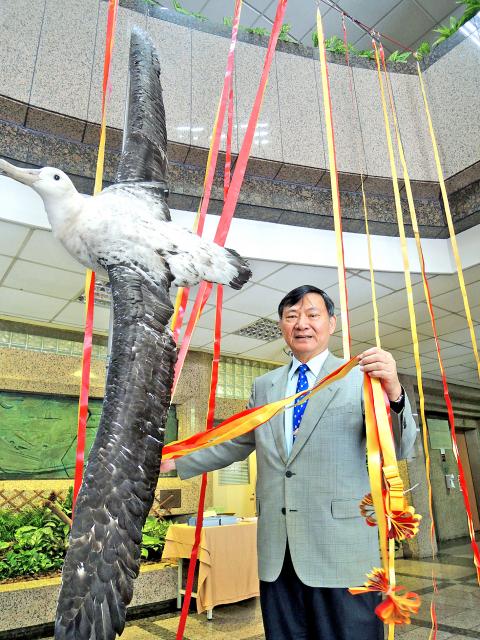The Fisheries Agency yesterday unveiled an updated national action plan to reduce the incidental catch of seabirds in the nation’s longline tuna fisheries to protect albatrosses and petrels, among others.
The agency said that, as one of the major tuna longline fisheries countries in the world, Taiwan has more than 1,000 longline vessels operating across three oceans that unintentionally affect seabird populations.
To reduce the bycatch of seabirds during fishing, the agency said that it developed the first edition of its National Plan of Action on Seabirds in 2006 in accordance with that adopted by the UN’s Food and Agriculture Organization.

Photo: Hsieh Wen-hua, Taipei Times
The agency updated its plan this year.
Fisheries Agency Director-General James Sha (沙志一) said that the agency has instructed fishing vessels to install two “bird-scaring” lines since 2006, reducing seabird bycatch by 50 percent.
He said that the new edition of the action plan would also require vessels to select at least two of the three other chosen methods to further reduce incidents of seabird bycatch.
Apart from installation of bird-scaring lines, fishing vessels might install weighted branch lines or choose to set up baits at night.
Nanhua University assistant professor Yeh Yu-min (葉裕民) said that the long-distance fishing fleet first extend a main fishing line, and the baits, such as pacific saury, are hung on the hooks of branch lines under the main line.
She said that albatrosses and other seabirds quickly eat those baits before the branch lines are submerged, adding that the hooks on the branches could result in the unintended catch of these birds. Unable to get themselves off the hooks, the birds drown.
“The bird-scaring lines will cause the birds to fly away from the fishing boats,” she said. “The branch lines will go under the sea faster if they are attached with lead blocks.”
Setting baits at night would prevent seabirds from approaching because they cannot see the baits, the agency said.

Taiwan is to commence mass production of the Tien Kung (天弓, “Sky Bow”) III, IV and V missiles by the second quarter of this year if the legislature approves the government’s NT$1.25 trillion (US$39.78 billion) special defense budget, an official said yesterday. Commenting on condition of anonymity, a defense official with knowledge of the matter said that the advanced systems are expected to provide crucial capabilities against ballistic and cruise missiles for the proposed “T-Dome,” an advanced, multi-layered air defense network. The Tien Kung III is an air defense missile with a maximum interception altitude of 35km. The Tien Kung IV and V

The disruption of 941 flights in and out of Taiwan due to China’s large-scale military exercises was no accident, but rather the result of a “quasi-blockade” used to simulate creating the air and sea routes needed for an amphibious landing, a military expert said. The disruptions occurred on Tuesday and lasted about 10 hours as China conducted live-fire drills in the Taiwan Strait. The Civil Aviation Administration (CAA) said the exercises affected 857 international flights and 84 domestic flights, affecting more than 100,000 travelers. Su Tzu-yun (蘇紫雲), a research fellow at the government-sponsored Institute for National Defense and Security Research, said the air

Taiwan lacks effective and cost-efficient armaments to intercept rockets, making the planned “T-Dome” interception system necessary, two experts said on Tuesday. The concerns were raised after China’s military fired two waves of rockets during live-fire drills around Taiwan on Tuesday, part of two-day exercises code-named “Justice Mission 2025.” The first wave involved 17 rockets launched at 9am from Pingtan in China’s Fujian Province, according to Lieutenant General Hsieh Jih-sheng (謝日升) of the Office of the Deputy Chief of the General Staff for Intelligence at the Ministry of National Defense. Those rockets landed 70 nautical miles (129.6km) northeast of Keelung without flying over Taiwan,

A strong continental cold air mass is to bring pollutants to Taiwan from tomorrow, the Ministry of Environment said today, as it issued an “orange” air quality alert for most of the country. All of Taiwan except for Hualien and Taitung counties is to be under an “orange” air quality alert tomorrow, indicating air quality that is unhealthy for sensitive groups. In China, areas from Shandong to Shanghai have been enveloped in haze since Saturday, the ministry said in a news release. Yesterday, hourly concentrations of PM2.5 in these areas ranged from 65 to 160 micrograms per cubic meter (mg/m³), and pollutants were